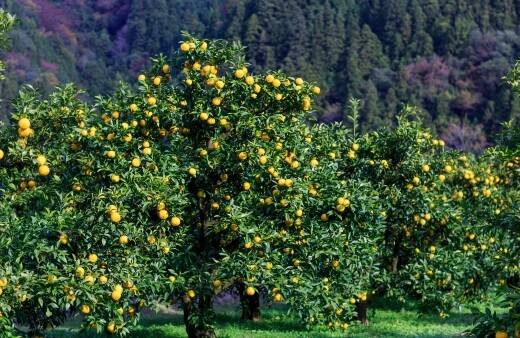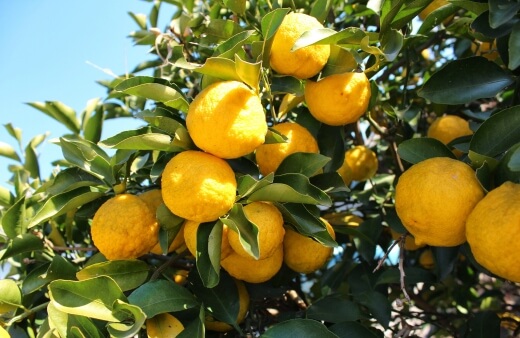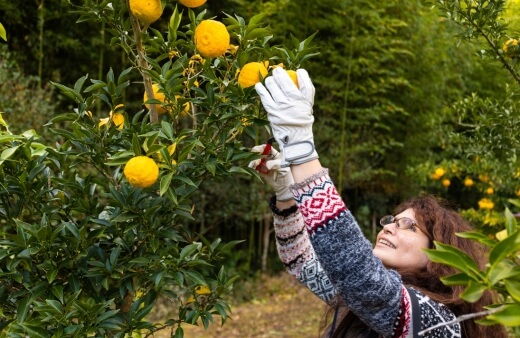Yuzu is such an intriguing plant. It’s been around for more than 1000 years and has made its way around the world as an exciting culinary ingredient, but also a promoter of wellness.
Our guide looks at the history of Yuzu and its features, how you can propagate your own (since Yuzu tends to be quite expensive), and caring for your plant which really is about a balance of enough sun and water. We’ve got some info about Yuzu’s culinary use and other uses, and pests and diseases that you might encounter.
More...

Family: | Rutaceae |
|---|---|
Species: | Citrus |
Botanical name: | Citrus x junos |
Common Names: | Yuzu, Japanese lemon |
Origin: | Japan |
Location: | Outdoor |
Type: | Fruit tree |
Growth: | Up to 8 metres tall and 5 metres wide |
Sun requirements: | Full sun |
Foliage Colour: | Green |
Flower Colour: | White |
Flowering: | Spring |
Fruit: | Tart, soft, sweet, looks very similar to lemon |
Maintenance level: | Average |
Poisonous for pets: | No |
Introducing Yuzu

Citrus x junos is often called Yuzu. It originated in China more than 1000 years ago and is a hybrid kind of citrus fruit. Part of the Rutaceae family, Yuzu comes from Asia and is native to Japan. More recently, the plant has been cultivated in Australia, Italy, and France, to name a few.
When ripe, the Yuzu is yellow and has the same size as a lemon. It’s flatter though and has very little skin or juice. The fruit is mostly seeds. The fruit has a unique taste which is both tart, yet soft and sweet. It is possible to propagate your own Yuzu or Citrus x junos.
Yuzu is incredibly hardy, more so than other citrus, and does well in many climates. In Japan, the Yuzu orchards appear on mountains and the trees handle the cold well but do need to be protected from the wind.
Yuzu produces flowers in the summer and is self-pollinating. The leaves are evergreen, leathery to the touch, and create a lush appearance, and the branches have sharp thorns that you’ll need to look out for. The tree flowers in the springtime with a lovely smelling fragrance, which is followed by the fruit.
How to Grow Yuzu in Australia

Yuzu grows slowly and can maintain a narrow shape, making it possible to grow in any size garden. Like any citrus plant, Yuzu likes growing conditions that provide full sun, soil that is well-draining but also nutrient rich, and it wants to be sheltered from the wind.
The younger trees need to be protected from weeds. When it comes to pests, you’ll need to be on the lookout for thrips which end up damaging both leaves and fruit.
Propagating Yuzu
It’s possible to propagate your own Yuzu using seed from the fruit of the tree itself. You’ll need to clean the seeds, and also check if any are damaged. Soak the Yuzu seeds in water for 24 hours. This process will help germination. Once the seeds have soaked, you can place them on tissue or a towel.
Once the seeds have been prepared, you can then sow the seeds in the prepared soil. You’ll need something well-draining, and we recommend adding some organic compost too. Make sure you wet the soil before sowing the seeds.
Once planted, place the container or pot somewhere that gets bright light, and when you see signs of germination, make sure you give the seedlings enough water. When the seedlings are ready for transplanting, create a hole that is 5 cm deep and wide.
Once planted, lightly press down the soil around the plant and be careful not to damage the roots. The ideal time to do the transplanting will depend on where you live.
If you stay somewhere that has a mild climate, you can aim to do your planting during autumn or spring. If your area has quite a cold winter, we recommend planting only in spring. It is possible to grow Yuzu either in a garden bed or otherwise in a pot.
How to Care for Yuzu

Sunlight
Plants that belong to the citrus family need bright sunlight and the Yuzu is no different. It will need lots of sun in order to thrive so be mindful of where you plant it.


Get Your Free Guide:
Master Growing Australian Natives eBook
A Must Have Complete Guide for Every Australian Garden
Get Your Free Guide:
Master Growing Australian Natives eBook
A Must Have Complete Guide for Every Australian Garden
Soil
Yuzu can cope with many different types of soil, provided it’s well-draining. A neutral to acidic pH is preferable, and the soil should be light and contain plenty of organic matter.
Watering Japanese Lemon
Watering your Yuzu plant is probably one of the most important care conditions it needs. Citrus plants do like a lot of water. If you live in an area with dry summers, the watering needs of your Yuzu are first priority.
A great way to prevent water loss from the soil is to add a layer of mulch like pine bark. This will also provide some organic matter when it breaks down so it has a double benefit.
Pruning
Yuzu plants have many thorns which can make the pruning process tricky. If you aim to prune your plant in a vase shape, it might help to access the tree for harvest as well without damaging it.
Fertiliser
Fertilise your Yuzu during its growing phase. If you’ve planted it in a pot, you’ll need to use a specific citrus fertiliser and will need to apply it over a few doses. You can apply a dose at the start of spring before blooming begins, another at the end of summer which helps with ripening fruit, and then a third one in autumn.
Yuzu Culinary Uses

As a flowering citrus fruit, Yuzu is related to lemon, grapefruit, lime and oranges. The taste of the Yuzu is quite unique. It’s refreshing, while being tart and having fragrance. It’s probably best described as a combination of lemon and mandarin orange, with a dash of lime and grapefruit.
With such a particular taste, Yuzu can be used in many different ways. You wouldn’t generally eat the fruit as is, but there are many ways to use every part of the Yuzu along with the peel and seeds. These along with the juice are great to add punch to vinegar and marmalade. You could also use it as a meat marinade.
In Japan, China and Korea particularly, where Yuzu is incredibly popular, it is used to make ponzu, a citrus-based sauce, and also yuzu vinegar. Yuzu is mixed with honey to form a syrup to make Yuzu tea, or can be used in alcoholic beverages. It’s the kind of ingredient that can be used for sweet or savoury purposes.
Yuzu can be stored at room temperature if you’re planning to use it soon, otherwise pop it in the fridge to make it stay fresh for longer. You can in fact freeze the entire Yuzu fruit for future use, or freeze the separate ingredients. The skin and flesh of the fruit will last about a month in the freezer, and frozen juice will keep for around 6 months.
Using Yuzu in Baths
Yuzu is truly an amazing culinary ingredient but it has some other great qualities and uses as well. The oil from the Yuzu skin has an incredible smell and it’s used to create fragrances. In Japan, popping Yuzu into your bath is a tradition that goes back to the 18th century.
The hot water of the bath helps to release the aroma. Sometimes the fruit would be halved to allow the citrus juice to mix with the water. The benefits were considered good for body and mind.
Health Benefits of Yuzu
Yuzu is packed with health benefits. Yuzu can be used to boost immunity. It contains vitamin C, and this is in every part of the fruit. It’s also packed with antioxidants which helps protect the body’s cells against damage that could cause disease.
A diet that is rich in antioxidants promotes brain health (improved memory and protection from stress), fights heart disease, diabetes, and cancer. If you are looking to keep your gut healthy,
Yuzu contains fibre that is great for the digestive system and can help manage symptoms of inflammatory bowel disease. Bone health is another benefit, with Yuzu containing flavonoids that support healthy bones, and this same factor also protects against blood clots.
The vitamin C in Yuzu also does its part for strong bones as it assists with collagen production. Going back to the fragrance benefits of Yuzu, it can be a wonderful stress reliever and is available in essential oil form.
Common Yuzu Pests and Diseases
Yuzu doesn’t struggle with too many pests. The more common ones are aphids, red spider mites, scale, and thrips. Neem oil is great for treating this variety of pests and others, or you can buy an appropriate insecticide for treatment purposes.
There isn’t much disease to be concerned about as Yuzu manages to resist these quite well. If you maintain sufficient water and sunlight for your plant, it will be well. If you notice that leaves are becoming pale, it might be a sign of too much water.
Let the plant dry out for a bit and then test moisture levels with your finger on the top layer of soil before watering again.
Also, check our guide if you spot citrus leaf curl to discover effective ways to address them.
Yuzu Frequently Asked Questions

How long does it take for Yuzu to produce fruit?
Yuzu is able to start producing fruit within one to two years of being planted.
What is the ornamental version of Yuzu?
It exists in Japan and is called hana yuzu. It is a type of Yuzu that is grown to produce flowers and not fruit.
What is the sweet variety of Yuzu called?
It is only available in Japan and is known as yuku. It became endangered in the 1970s and 1980s and there was much effort made towards supporting growth of this variety.
Why is Yuzu good for the skin?
Yuzu stimulates collagen production which helps to even out fine lines and wrinkles and boosts the skin’s elasticity. It also slows down the ageing process of our skin.
Is Yuzu expensive?
Yuzu carries a hefty price tag because of the supply and demand of the fruit. Japan grows the majority of the global supply, and a large amount of the fruit is used within the country.
How will I know when my Yuzu is ripe?
When Yuzu is ripe, it is round and will be sized between a lemon and grapefruit. It should have a golden yellow colour with some touches of green on the skin.
Sign up for our newsletter for more gardening advice and guides.
Wrapping Up Our Yuzu Growing Guide
Growing your own Yuzu could be considered a treasure. The many benefits that the fruit provides in terms of culinary use and towards well-being is motivation enough. The tree keeps good shape, doesn’t have many pests and disease, and you might be enjoying its fruit within a year of planting.
Published on April 17, 2023 by Maisie Blevins
Last Updated on February 23, 2025




